-
Enjoy XS650.com? Consider making a donation to help support the site.
XS650.com receives a small share of sales from some links on this page, but direct donations have a much greater impact on keeping this site going.
You are using an out of date browser. It may not display this or other websites correctly.
You should upgrade or use an alternative browser.
You should upgrade or use an alternative browser.
Battery box rust What's best way to deal with it.
- Thread starter gggGary
- Start date
-
- Tags
- restoration
But my Yamaha dealer doesn't HAVE a new one.
Here's one on ebay for $29.00, nice shape!

except it's not the right one.
Another, this guy wants $75

It's wrong also.
Here's one on ebay for $29.00, nice shape!
except it's not the right one.
Another, this guy wants $75
It's wrong also.
But my Yamaha dealer doesn't HAVE a new one.
Here's one on ebay for $29.00, nice shape!
except it's not the right one.
Another, this guy wants $75
It's wrong also.
Hi Gary,
the battery box in the first post is in better shape than either of those and Kevski's right, the best place for that one is in the scrap pile.
Or, if those two rusted ruins sell, put yours on e-bay too.
Then buy a length of 1" x 1/8" flat bar and weld yourself a new one.
NONclow
Confirmed Laquer Breather
FWIW:
1. All my tests were done outdoors.
2. More amperage does the job quicker. 2A you'll be there for days, 10A puts it on the back burner, 30A with sufficient anode surface area and washing soda solution... puts it on the boil.
puts it on the boil.
3. As stated, they don't make these any more. When one can be ressurected....or even restored by YOUR OWN HAND! Kinda says somethin'
1. All my tests were done outdoors.
2. More amperage does the job quicker. 2A you'll be there for days, 10A puts it on the back burner, 30A with sufficient anode surface area and washing soda solution...
3. As stated, they don't make these any more. When one can be ressurected....or even restored by YOUR OWN HAND! Kinda says somethin'

I have an old shumacher 2/10/50 charger Got the wash soda and a plastic 5 gallon bucket maybe some rusty mig wire for the anode. Will mess around with a small set up for carb brackets, nut and bolts also.
Is there a formula for the wash soda amount?
Is there a formula for the wash soda amount?
If going the electro route use a stainless steel plate as cathode, the battery box will be your anode, wire brush the box well, you would be better off using caustic soda then rinse well with de-ionised water to rid the box of caustic then dry as quickly as possible to avoid flash rusting.
NONclow
Confirmed Laquer Breather
.....Is there a formula for the wash soda amount?
One tablespoon of washing soda to one gallon of water. Any weaker, it doesn't work as well.....AND stronger won't adversely affect it either. Anything over nets virtually the same results (but won't hurt). Once all the rust is converted the reaction stops.
Stainless is definately not desired, neither is galvanized. Salvaged car sheet metal, and a little labor to cut them, will be the cheap and ready way for me to replace the rotting anodes, espescially if they will keep deteriorating.....
I also seem to shut it down mid-process and aggitate the item(s) to break up the skin of magnetite building on the surface. Does it work?
 the jury's still out....
the jury's still out....
Last edited:
Read a round a bit,
Used the "majority rule" method of design, went and picked through the junk and....
5 gallon plastic bucket
about 15' of old barbed wire wound inside the bucket. Should give good line of sight, the wire is evenly spread top to bottom and all around. (Non rusty would be better but this is working so far.)
Some plastic mesh screen I had to reduce the odds of the battery box touching the barbed wire.
An old battery charger set at 10 amps 12 volts.
about 1/2 cup of Arm and Hammer Super wash soap
Used hot soft water to fill the bucket, speeds up dissolving the soda and reactions?
red wire on the barbed wire, black to the part.
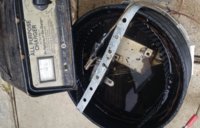
Now it's bubbling away.
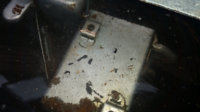
Breathless updates later.
Notes; New "Automatic" battery chargers won't work unless you also have a "good" battery in parallel with the solution.
A few "internet experts" cautioned against stainless, galvanized, zinc copper etc. cathode, shrug, carbon is noted as an ideal cathode. Much or most of my old metal is either painted or galvanized, neither is a good thing for the sacrificial plate.
The ding against stainless is that it contains chromium no reason make a witches brew out of your waste "water".
Thought this was a good do/don't list.
"check the label of the "Laundry Soda" and make sure it's actually (mostly) sodium carbonate. If it's not the first material listed, I'd say try again. (don't use Borax)
don't use galvanized materials. The process should still work- I'm not sure- but the zinc leaches out into the water. No reason to contaminate it, especially if you're going to be disposing of it by dumping it on the lawn, in a storm sewer or down the drain.
add more sacrificial plate. The positive or waste plate should be roughly the same surface area as you're trying to strip. A small sheet of 22 or 24 ga sheetmetal is cheap, and easy to cut into sections with some snips. Or be creative- I used a bunch of pieces left over from dismantling a large copier, and you might find somebody throwing away an old microwave or something, that you can cut some panels off of. Any clean steel will do, and it gets nasty-rusty, so make it cheap as possible and stuff you won't mind throwing away.
It's a slow process, and slower still if you have a very small positive plate. Expect the process to take at least all day, overnight. Large pieces with heavy rust could take several days. It won't hurt a thing to leave it in even longer. Some people have said that a low amperage and longer time does a more thorough cleaning.
The data: Red/positive to the waste plate(s), black/negative to the piece to be stripped. About 1/3rd to 1/2 cup of washing soda or baking soda per five gallons of water. Don't use galvanized, don't use stainless steel. Have a hose and several stiff brushes to give it a good scrubbing when you're done. I use a small wire toothbrush on some stubborn spots. Have a good protectant on hand, as it'll instantly get surface rust as soon as it dries."
Doc.
The labeling of cathode and anode is a bit confusing but I guess since this is a power "consuming" device; the plus side is the anode, the negative side, the part being de-rusted, is the cathode.
From Wikipedia;
The polarity of voltage on an anode with respect to an associated cathode varies depending on the device type and on its operating mode. In the following examples, the anode is positive in a device that consumes power, and the anode is negative in a device that provides power:
In a discharging battery or galvanic cell (diagram at right), the anode is the negative terminal because it is where the current flows into "the device" (i.e. the battery cell). This inward current is carried externally by electrons moving outwards, negative charge moving one way constituting positive current flowing the other way.
In a recharging battery, or an electrolytic cell, the anode is the positive terminal, which receives current from an external generator. The current through a recharging battery is opposite to the direction of current during discharge; in other words, the electrode which was the cathode during battery discharge becomes the anode while the battery is recharging.
Used the "majority rule" method of design, went and picked through the junk and....
5 gallon plastic bucket
about 15' of old barbed wire wound inside the bucket. Should give good line of sight, the wire is evenly spread top to bottom and all around. (Non rusty would be better but this is working so far.)
Some plastic mesh screen I had to reduce the odds of the battery box touching the barbed wire.
An old battery charger set at 10 amps 12 volts.
about 1/2 cup of Arm and Hammer Super wash soap
Used hot soft water to fill the bucket, speeds up dissolving the soda and reactions?
red wire on the barbed wire, black to the part.

Now it's bubbling away.

Breathless updates later.
Notes; New "Automatic" battery chargers won't work unless you also have a "good" battery in parallel with the solution.
A few "internet experts" cautioned against stainless, galvanized, zinc copper etc. cathode, shrug, carbon is noted as an ideal cathode. Much or most of my old metal is either painted or galvanized, neither is a good thing for the sacrificial plate.
The ding against stainless is that it contains chromium no reason make a witches brew out of your waste "water".
Thought this was a good do/don't list.
"check the label of the "Laundry Soda" and make sure it's actually (mostly) sodium carbonate. If it's not the first material listed, I'd say try again. (don't use Borax)
don't use galvanized materials. The process should still work- I'm not sure- but the zinc leaches out into the water. No reason to contaminate it, especially if you're going to be disposing of it by dumping it on the lawn, in a storm sewer or down the drain.
add more sacrificial plate. The positive or waste plate should be roughly the same surface area as you're trying to strip. A small sheet of 22 or 24 ga sheetmetal is cheap, and easy to cut into sections with some snips. Or be creative- I used a bunch of pieces left over from dismantling a large copier, and you might find somebody throwing away an old microwave or something, that you can cut some panels off of. Any clean steel will do, and it gets nasty-rusty, so make it cheap as possible and stuff you won't mind throwing away.
It's a slow process, and slower still if you have a very small positive plate. Expect the process to take at least all day, overnight. Large pieces with heavy rust could take several days. It won't hurt a thing to leave it in even longer. Some people have said that a low amperage and longer time does a more thorough cleaning.
The data: Red/positive to the waste plate(s), black/negative to the piece to be stripped. About 1/3rd to 1/2 cup of washing soda or baking soda per five gallons of water. Don't use galvanized, don't use stainless steel. Have a hose and several stiff brushes to give it a good scrubbing when you're done. I use a small wire toothbrush on some stubborn spots. Have a good protectant on hand, as it'll instantly get surface rust as soon as it dries."
Doc.
The labeling of cathode and anode is a bit confusing but I guess since this is a power "consuming" device; the plus side is the anode, the negative side, the part being de-rusted, is the cathode.
From Wikipedia;
The polarity of voltage on an anode with respect to an associated cathode varies depending on the device type and on its operating mode. In the following examples, the anode is positive in a device that consumes power, and the anode is negative in a device that provides power:
In a discharging battery or galvanic cell (diagram at right), the anode is the negative terminal because it is where the current flows into "the device" (i.e. the battery cell). This inward current is carried externally by electrons moving outwards, negative charge moving one way constituting positive current flowing the other way.
In a recharging battery, or an electrolytic cell, the anode is the positive terminal, which receives current from an external generator. The current through a recharging battery is opposite to the direction of current during discharge; in other words, the electrode which was the cathode during battery discharge becomes the anode while the battery is recharging.
1st breathless update!
1.5 hours in the bucket a bit of scrubbing with a stainless steel brush.
We have a winner. It's back in the bucket for 10 hours now.
Before, this was after the previous 4 hours in venegar and brushing;
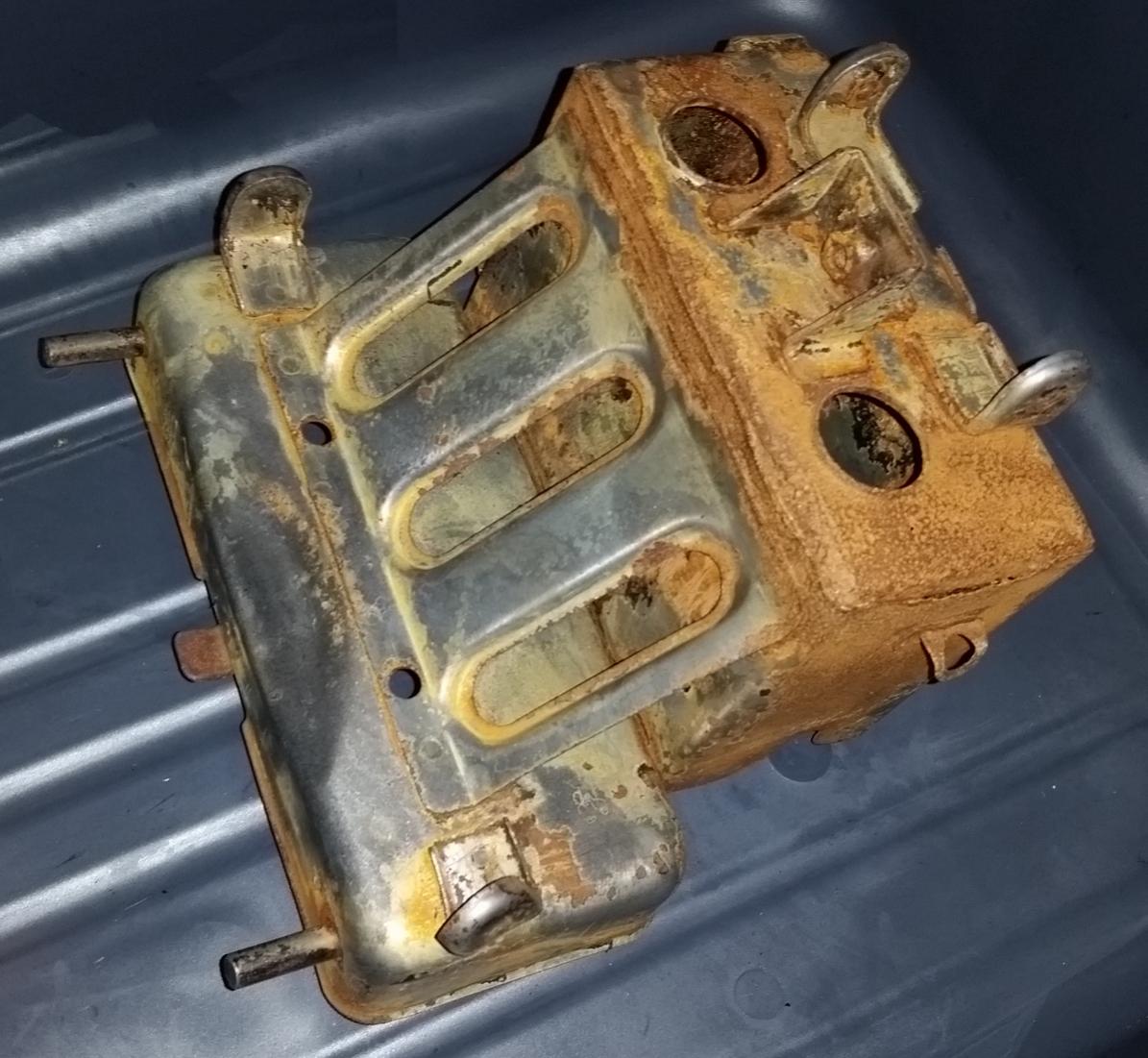
After 1 1/2 hours of electrolysis. Charger on the 10 amp setting. It flash rusted a bit when I used a blow dryer on it so the pic would be apples to apples with the one after 4 hours in vinegar.

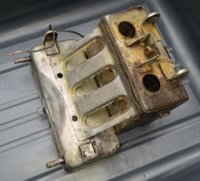
NONclow I'd hug you if you were closer! This is awesome. Hmm, if I could find a swimming pool to put my van in..........
1.5 hours in the bucket a bit of scrubbing with a stainless steel brush.
We have a winner. It's back in the bucket for 10 hours now.
Before, this was after the previous 4 hours in venegar and brushing;
After 1 1/2 hours of electrolysis. Charger on the 10 amp setting. It flash rusted a bit when I used a blow dryer on it so the pic would be apples to apples with the one after 4 hours in vinegar.

NONclow I'd hug you if you were closer! This is awesome. Hmm, if I could find a swimming pool to put my van in..........
Royboy
many roads, little time
- Messages
- 1,079
- Reaction score
- 199
- Points
- 63
See Gary, Way back to the muffler collar nut dilemma I was telling you "ELECTROLYSIS". It's the big answer to dissolving your bike one piece at a time.
roy

roy
tonyc
XS650 Guru
Powder Coat.
NONclow
Confirmed Laquer Breather
You're welcome bro! Glad to help.
.....swimming pool huh?
http://antique-engines.com/trailer-electrolysis.htm
.....swimming pool huh?
http://antique-engines.com/trailer-electrolysis.htm
10 more hours in the bath, wire brushing, nylox wheel, and scraping.
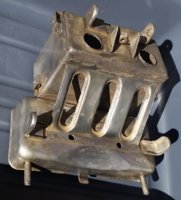
I have some 2 part epoxy clear. I think I will mix up a few small batches and brush on, fill, smooth, reinforce, pits, seams, eroded edges etc. then paint with high build fleet black.
The next bath version.
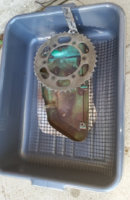
I have a bunch of side covers to derust.
Planning stage, a small one for nuts, bolts, carb brackets etc. powered by a DC wall wort. that can sit on the carb bench. Idea stage; one combined with an ultrasonic transducer!

I have some 2 part epoxy clear. I think I will mix up a few small batches and brush on, fill, smooth, reinforce, pits, seams, eroded edges etc. then paint with high build fleet black.
The next bath version.

I have a bunch of side covers to derust.
Planning stage, a small one for nuts, bolts, carb brackets etc. powered by a DC wall wort. that can sit on the carb bench. Idea stage; one combined with an ultrasonic transducer!
See Gary, Way back to the muffler collar nut dilemma I was telling you "ELECTROLYSIS". It's the big answer to dissolving your bike one piece at a time.
roy
Roy that muffler nut is STILL stuck, I even got all aggressive and flexed it back and forth with the 40 ton press, then back on the rattle gun still no joy. I may give electrolysis a try next.
An idea for removing rust from car body sheet metal has formed.
racerdave
^ Gone not forgotten ^
Gary I seen that van. You need at least a pond.
So far through the the bath; the battery box, 2 headlight shells and 5 early sidecovers,
1 chromed fork cover just to see what happens to rusty chrome. I need to do a few more chrome parts to get a good feel for it.
the 2-10-50 charger seems to be working well. Beyond line of sight, I think anode, cathode distance also is critical. Most of the action takes place at the part of surface closest to the anode. For example up inside the sidecovers does not clean as well as the "edges" sitting close to the anode. Up soon are a few ideas for nuts and bolts cleaning.
Doing a rusted stuck muffler nut, we will see how that goes. My theory is that line of sight is really line of electro-magnetic field so a rag as a spacer/insulator should work fine.
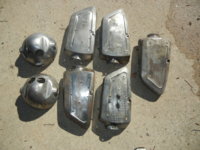
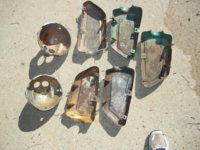
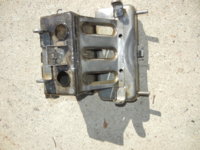
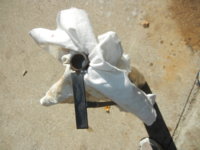
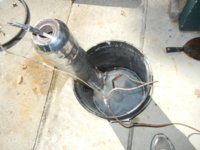
1 chromed fork cover just to see what happens to rusty chrome. I need to do a few more chrome parts to get a good feel for it.
the 2-10-50 charger seems to be working well. Beyond line of sight, I think anode, cathode distance also is critical. Most of the action takes place at the part of surface closest to the anode. For example up inside the sidecovers does not clean as well as the "edges" sitting close to the anode. Up soon are a few ideas for nuts and bolts cleaning.
Doing a rusted stuck muffler nut, we will see how that goes. My theory is that line of sight is really line of electro-magnetic field so a rag as a spacer/insulator should work fine.





Out of curiosity I did the front badge and chromed front motor mount. The badge plate did ok and the front of the motor mount. The back/inside of the motor mount not so much.
That is when I switched to vinegar. Total coverage and the time factor isn't that much more. On the plus side (for those trying to conserve) no more energy is consumed in the process.
That is when I switched to vinegar. Total coverage and the time factor isn't that much more. On the plus side (for those trying to conserve) no more energy is consumed in the process.
I wonder if some sort of agitation would help, like from an aquarium pump, or one of those small tabletop water fountain pumps...
View attachment 57824
Out of the bath, the rag between the the part and anode worked great. actually kind of works to keep the bath water cleaner, the generated anode rust stays in the rag.
This and a better impact nut wrench got the nut off the muffler and saved the threads.
Out of the bath, the rag between the the part and anode worked great. actually kind of works to keep the bath water cleaner, the generated anode rust stays in the rag.
This and a better impact nut wrench got the nut off the muffler and saved the threads.
Had some collets and carb parts that needed derusting, tried Sunnyside rust remover (Evaporust reverse engineered?)
Before
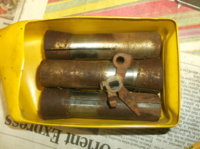
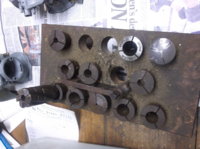
After removing from the fluid, dry, a bit of stainless wire brush and buffing on the collets. Couple of the collets to go yet.
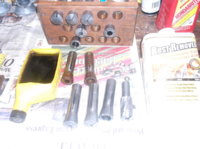
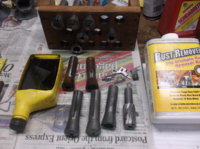
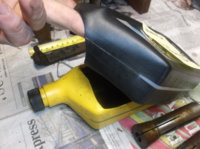
Dang I wish I had tried this stuff sooner, $10 a quart or $20 a gallon. No doubt my next buy wil be a gallon. I will get all those parts clean with about a pints worth of cleaner.
Doesn't hurt to wire brush heavy rust first, degrease if needed, maybe scrub heavy rust again part way through the soak. It seems that room temp makes a difference, warmer speeds up the action quite a bit. 2-3 hours seemed to do the trick on those collets, I left some in overnight with no ill effects.
Before


After removing from the fluid, dry, a bit of stainless wire brush and buffing on the collets. Couple of the collets to go yet.



Dang I wish I had tried this stuff sooner, $10 a quart or $20 a gallon. No doubt my next buy wil be a gallon. I will get all those parts clean with about a pints worth of cleaner.
Doesn't hurt to wire brush heavy rust first, degrease if needed, maybe scrub heavy rust again part way through the soak. It seems that room temp makes a difference, warmer speeds up the action quite a bit. 2-3 hours seemed to do the trick on those collets, I left some in overnight with no ill effects.
Last edited:
